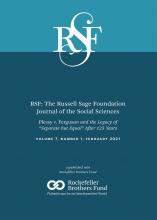Research Article
Open Access
Does the Negro Need Separate Schools? A Retrospective Analysis of the Racial Composition of Schools and Black Adult Academic and Economic Success
Timothy M. Diette, Darrick Hamilton, Arthur H. Goldsmith, William A. Darity, Jr.
RSF: The Russell Sage Foundation Journal of the Social Sciences February 2021, 7 (1) 166-186; DOI: https://doi.org/10.7758/RSF.2021.7.1.10
Timothy M. Diette
aProfessor of economics and senior advisor to the president for strategic analysis at Washington and Lee University, United States
Darrick Hamilton
bHenry Cohen Professor of Economics and Urban Policy and founding director of the Institute for the Study of Race, Stratification, and Political Economy at the New School, United States
Arthur H. Goldsmith
cJackson T. Stephens Professor of Economics at the Williams School of Commerce, Economics, and Politics at Washington and Lee University, United States
William A. Darity Jr.
dSamuel DuBois Cook Professor of Public Policy, African and African American Studies, and Economics at Duke University, United States

REFERENCES
- ↵
- Aaronson, Daniel, and
- Bhashkar Mazumdar
- ↵
- Ascoli, Peter M
- ↵
- Autor, David H.,
- Lawrence F. Katz, and
- Melissa S. Kearney
- ↵
- Bell, Derrick A., Jr.
- ↵
- Bifulco, Robert
- Bifulco, Robert,
- Jason M. Fletcher, and
- Stephen L. Ross
- ↵
- Blumer, Herbert
- ↵
- Boozer, Michael A.,
- Alan B. Krueger, and
- Shari Wolkon
- ↵
- Braddock, Jomills Henry, and
- James M. McPartland
- ↵
- Camera, Lauren
- ↵
- Card, David, and
- Jesse Rothstein
- ↵
- Clotfelter, Charles T
- ↵
- ↵
- Condron, Dennis, and
- Vincent Roscigno
- ↵
- Corso, Phaedra S.,
- Valerie J. Edwards,
- Xiangming Fang, and
- James A. Mercy
- ↵
- ↵
- ↵
- Darity, William, Jr.
- ↵
- ↵
- Darity, William, Jr.., and
- Alicia Jolla
- ↵
- ↵
- Diette, Timothy M
- ↵
- ↵
- Douglas, Davison M
- ↵
- Du Bois, W.E.B
- ↵
- Du Bois, W.E.B
- ↵
- Dube, Shanta R.,
- David F. Williamson,
- Ted Thompson,
- Robert F. Anda, and
- Vincent J. Felitti
- ↵
- Fiela, Jeremy E
- ↵
- Francis, Dania V., and
- William A. Darity Jr.
- ↵
- Gleibermann, Erik
- ↵
- Goldsmith, Arthur H.,
- Darrick Hamilton, and
- William Darity Jr.
- ↵
- Grissom, Jason A., and
- Christopher Redding
- ↵
- Guryan, Jonathan
- ↵
- Hamilton, Darrick
- ↵
- Hamilton, Darrick
- ↵
- Hanushek, Eric A.,
- John F. Kain, and
- Steven G. Rivkin
- ↵
- Hardt, Jochen, and
- Michael Rutter
- ↵
- ↵
- Jablonskia, Nina G., and
- George Chaplin
- ↵
- Jackson, James S., and
- Gerald Gurin
- ↵
- Johnson, Rucker C
- ↵
- Johnson, Rucker C., and
- Alexander Nazaryan
- ↵
- Keil, Julian E.,
- Susan E. Sutherland,
- Rebecca G. Knapp,
- Herman A. Tyroler, and
- William S. Pollitzer
- ↵
- Lewis, W. Arthur
- ↵
- Lewis, Amanda E., and
- John B. Diamond
- ↵
- Lindsay, Constance A., and
- Cassandra M.D. Hart
- ↵
- Lucas, Samuel Roundfield
- ↵
- ↵
- Morgan, Ivy, and
- Ary Amerikaner
- ↵
- ↵
- Oakes, Jeanie
- ↵
- Orfield, Gary, and
- Chungmei Lee
- ↵
- Orfield, Gary, and
- Chungmei Lee
- ↵
- Reber, Sarah J
- ↵
- Rivkin, Steven G
- ↵
- Thomas, Karen Kruse
- ↵
- Tyson, Karolyn,
- William Darity Jr.., and
- Domini Castellino
- ↵
- Yancura, Loriena A., and
- Carolyn M. Aldwin
In this issue
Does the Negro Need Separate Schools? A Retrospective Analysis of the Racial Composition of Schools and Black Adult Academic and Economic Success
Timothy M. Diette, Darrick Hamilton, Arthur H. Goldsmith, William A. Darity
RSF: The Russell Sage Foundation Journal of the Social Sciences Feb 2021, 7 (1) 166-186; DOI: 10.7758/RSF.2021.7.1.10
Does the Negro Need Separate Schools? A Retrospective Analysis of the Racial Composition of Schools and Black Adult Academic and Economic Success
Timothy M. Diette, Darrick Hamilton, Arthur H. Goldsmith, William A. Darity
RSF: The Russell Sage Foundation Journal of the Social Sciences Feb 2021, 7 (1) 166-186; DOI: 10.7758/RSF.2021.7.1.10
Jump to section
- Article
- Abstract
- CONCEPTUAL FRAMEWORK
- STRATIFICATION ECONOMICS, FUNCTIONAL ROLE OF DISCRIMINATION THEORY, AND SCHOOL INTEGRATION
- PREDICTING THE LINK BETWEEN RACIAL COMPOSITION OF PEERS AND EDUCATIONAL ATTAINMENT
- DATA, MEASUREMENT, AND DESCRIPTIVE STATISTICS
- METHODOLOGY
- RESULTS
- HIGH SCHOOL RACIAL COMPOSITION: LINKAGES TO EMPLOYMENT AND HOMEOWNERSHIP
- CONCLUSION
- FOOTNOTES
- REFERENCES
- Figures & Data
- Info & Metrics
- References
Related Articles
- No related articles found.
Cited By...
- No citing articles found.





